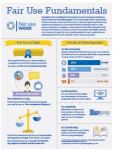[caption id="attachment_1314" align="alignleft" width="114"] Click on the image for more information about fair use.[/caption]
The legal concept of fair use touches our lives every day, especially those who are employed in, or are students at, educational institutions. It is one of the exemptions to copyright law and serves as an important limitation on copyright holders. Fair use is what allows you to make copies of copyrighted articles without asking the author for permission. It is what allows faculty member to show movies in their classes without securing public performance rights.
Fair use as a legal doctrine came about in 1841 when Justice Joseph Story, in the case of Folsom v. Marsh, wrote the decision that led to fair use as a part of the copyright law.
Fair Use Week is typically the last week in February. This year it is February 23-27, 2015.
Click on the image for more information about fair use.[/caption]
The legal concept of fair use touches our lives every day, especially those who are employed in, or are students at, educational institutions. It is one of the exemptions to copyright law and serves as an important limitation on copyright holders. Fair use is what allows you to make copies of copyrighted articles without asking the author for permission. It is what allows faculty member to show movies in their classes without securing public performance rights.
Fair use as a legal doctrine came about in 1841 when Justice Joseph Story, in the case of Folsom v. Marsh, wrote the decision that led to fair use as a part of the copyright law.
Fair Use Week is typically the last week in February. This year it is February 23-27, 2015.
 Click on the image for more information about fair use.[/caption]
The legal concept of fair use touches our lives every day, especially those who are employed in, or are students at, educational institutions. It is one of the exemptions to copyright law and serves as an important limitation on copyright holders. Fair use is what allows you to make copies of copyrighted articles without asking the author for permission. It is what allows faculty member to show movies in their classes without securing public performance rights.
Fair use as a legal doctrine came about in 1841 when Justice Joseph Story, in the case of Folsom v. Marsh, wrote the decision that led to fair use as a part of the copyright law.
Fair Use Week is typically the last week in February. This year it is February 23-27, 2015.
Click on the image for more information about fair use.[/caption]
The legal concept of fair use touches our lives every day, especially those who are employed in, or are students at, educational institutions. It is one of the exemptions to copyright law and serves as an important limitation on copyright holders. Fair use is what allows you to make copies of copyrighted articles without asking the author for permission. It is what allows faculty member to show movies in their classes without securing public performance rights.
Fair use as a legal doctrine came about in 1841 when Justice Joseph Story, in the case of Folsom v. Marsh, wrote the decision that led to fair use as a part of the copyright law.
Fair Use Week is typically the last week in February. This year it is February 23-27, 2015.
